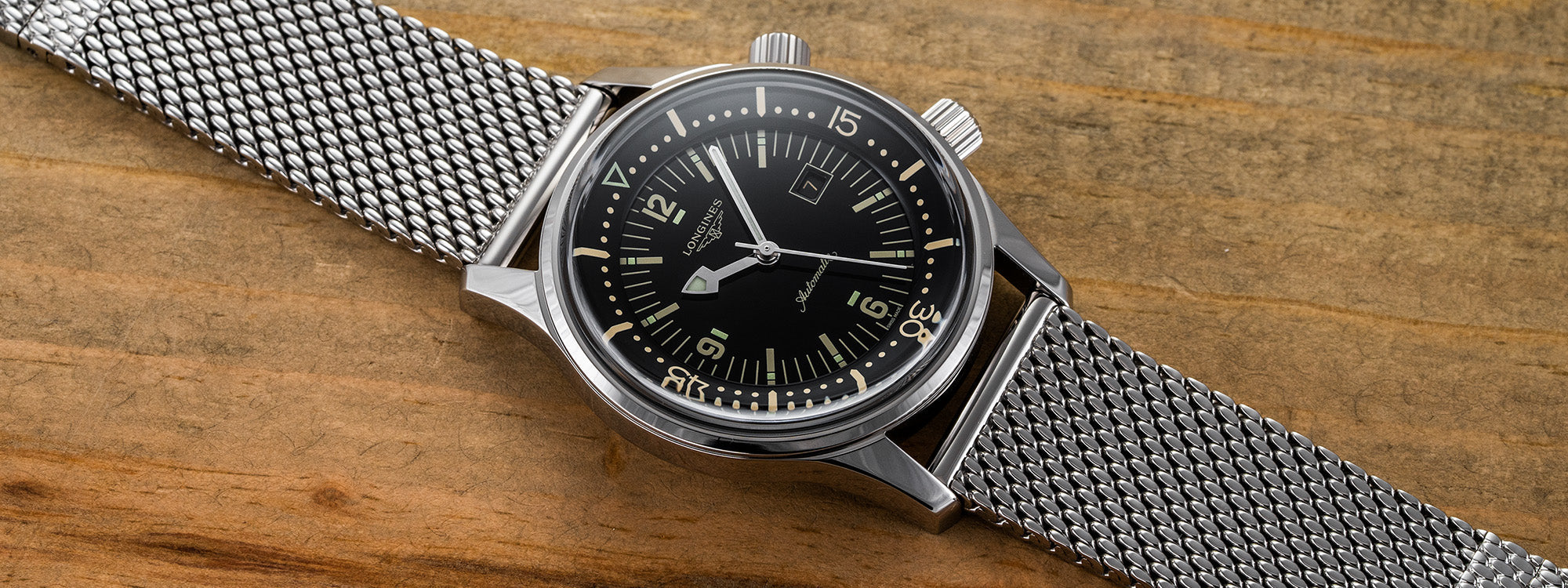Among the many decisions facing a prospective watch buyer before pulling the trigger on a new timepiece, is choosing which type of strap or bracelet it should have. We covered the various types of watch straps in this article; read on for our rundown of the most popular watch bracelets, focusing on some of the influential, proprietary styles from brands like Rolex and Breitling, which have impacted numerous other brands’ designs, as well as more niche-oriented options geared to collectors and historical-minded enthusiasts.
Oyster Bracelet

Rolex’s iconic Oyster bracelet is the template from which many other three-link bracelet styles have been drawn. Its name comes from its association with the Oyster case, which Rolex first introduced in 1926 and for which the original version of this bracelet served as an extension. Oyster bracelets are recognizable for their wide center links bordered by thinner end-links. Rolex patented the design in 1947 and fitted one on a watch in 1948. In the early versions, the links were riveted; these were phased out in favor of a “folding” style in 1967, which eventually gave way to the modern, solid-link style in 1975. Three-link bracelets like the Oyster and its various descendants are particularly popular on sports watches and dive watches.
President Bracelet

The Rolex Day-Date appeared on the market in 1956 and with it came a new three-link bracelet called the President. Intended as the epitome of Rolex’s luxurious bracelet options, and initially made only in precious metals, its links are semicircular-shaped, with wider links on the center and thinner ones on the edges. The President bracelet remains almost exclusively the property of the Day-Date models (which, not coincidentally, are also nicknamed “President”), though they are also found on some Datejust and Lady Datejust models. The bracelet, in fact, was named before the watch, signaling that the Crown had always hoped to market the Day-Date as a favorite watch of chief executives and other powerful figures.
Jubilee Bracelet

While it’s not as ubiquitous as the Oyster bracelet, the Jubilee was actually the first bracelet style that Rolex made in-house. Renowned for its five-link design, with three rows of smaller center links flanked by two rows of larger links on each side, it made its debut on the watch for which it was specifically designed, the first Rolex Datejust, in 1945. At the time, the Jubilee, still considered one of Rolex’s dressiest and most luxurious bracelet options, was offered only in solid gold; today the brand makes it in various metals and bi-metal iterations. This was partly due to the Jubilee’s eventual adoption by sportier models like the GMT-Master as well as the elegant Datejust, after the introduction of the President bracelet (see below). Over the years, the link styles and shapes have subtly changed, from folded to D-shaped to oval-shaped to solid. Since there are more individual links in this type of bracelet, it tends to be a little more form fitting than the three-link style, though the latter is generally thought of as more robust since the links themselves are larger.
Oysterflex Bracelet

Dating back only to 2015, and thus far still exclusive to Rolex and not emulated by any other brand, is the Oysterflex bracelet, which many observers might prefer to categorize as a strap because of its black rubber exterior. However, the Oysterflex, which made its debut on the first Rolex GMT-Master model in Everose Gold, is actually much more complex in construction than an initial glance would reveal. Its interior houses a patented “longitudinal cushion” system, composed of titanium and nickel-alloy blades wrapped inside black elastomer, which gives the Oysterflex the rigidity and stability of a metal bracelet while still offering the softness and suppleness of a strap.
Rouleaux Bracelet

When Breitling reinvented its Chronomat model in 1984, in commemoration of the Swiss maison’s 100th anniversary, it also developed an entirely new bracelet style for the watch. The Rouleaux (French for “rollers”) bracelet was distinguished from others at the time by its single-row arrangement of long, round-tipped cylindrical links that resembled bullets or capsules. (It was often nicknamed the “bullet bracelet.”) The Rouleaux bracelet, a favorite of Breitling wearers in the 1980s and ‘90s, especially in its two-tone steel-and-gold version, was discontinued around the turn of the millennium but made a comeback in 2020 as an option in yet another revamp of the Chronomat family. The modern Rouleaux bracelets have sleeker-looking links with brushed surfaces, polished bevels, and polished mid-link bands that can also be finished in gold for additional contrast.
Beads-of-Rice Bracelet

Brought back into vogue in the 1980s by influential watches like the Doxa SUB 300, the “beads of rice” metal bracelet dates back to the 1940s, when watchmakers like Patek Philippe and Vacheron Constantin first began using the style. This type of bracelet is defined by 7 to 10 rows of small, bead-shaped links (sometimes bordered on the sides by larger links) interlocking with each other in a chainmail-like pattern for a very supple feel on the wrist. Watches with beads-of-rice bracelets have an undeniable vintage look, and a style that leans more into elegant than sporty.
Milanese Bracelet

Similar to the “beads-of-rice” bracelet and venturing somewhat further into strap territory is the metal-mesh bracelet referred to these days as “Milanese” or, in some quarters of dive-watch enthusiasts, “Shark Mesh.” Identifiable by its series of small metal wires woven into a mesh pattern, it derives its name from a technique perfected in 19th-century Milan and is much more adjustable in minuscule increments thanks to its lack of individual links and the presence of a lockable clasp that can be disengaged and moved along its length. Style-wise, Milanese straps can be dressed up or down, they’re built to last longer than straps made of leather or fabrics, and depending on the timepiece can look either vintage or contemporary.
Integrated Bracelet

Ladder Bracelet

Many of the bracelet styles featured here, including the original Rolex Oyster, the first Royal Oak bracelet, and many early “beads-of-rice” examples, spring from the same creative wellspring — the Swiss company Gay Frères, which at one point was the primary maker of bracelets for all the Swiss watch industry’s most important brands, as well as provider of jewelry for firms like Hermès and Van Cleef & Arpels. Absorbed by Rolex in 1998, Gay Frères also produced an emblematic bracelet nicknamed the “ladder” in the late 1960s and early ‘70s, primarily for use by Zenith on its El Primero watches. Zenith revived the Gay Frères-style ladder bracelet in recent years, adding it as an option on many of the brand’s Revival models, which faithfully evoke vintage El Primero watches of that same era. The ladder bracelet takes its name from its three-link design with wide gaps between the center links, a design that minimizes skin contact with metal and creates lightness on the wrist. Ladder bracelets have yet to reach a level of popularity to rival their mid-20th-century heyday, but with the watch industry’s continuing embrace of vintage styles, who knows how many we’ll see in the coming years?



























































0 Comments